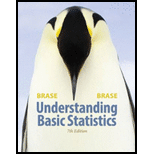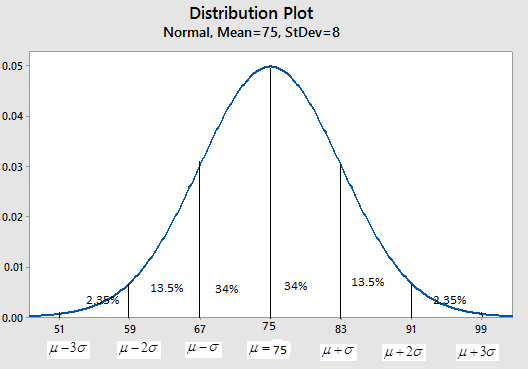
For Problems 5-14, please provide the following information.
(a) What is the level of significance? State the null and alternate hypotheses.
(b) Find the value of the chi-square statistic for the sample. Are all the expected frequencies greater than 5? What sampling distribution will you use? What are the degrees of freedom?
(c) Find or estimate the P-value of the sample test statistic.
(d) Based on your answers in parts (a)-(c), will you reject or fail to reject the null hypothesis that the population fits the specified distribution of categories?
(e) Interpret your conclusion in the context of the application
Meteorology:
| I | II | III | IV |
| Region under Normal Curve |
|
Expected % from Noraml Curve | Observed Number of Days in 20 Years |
|
|
|
2.35% | 16 |
|
|
|
13.5% | 78 |
|
|
|
34% | 212 |
|
|
|
34% | 221 |
|
|
|
13.5% | 81 |
|
|
|
2.35% | 12 |
(i) Remember that
(ii) Use a 19 level of significance to test the claim that the average daily. July temperature follows a normal distribution with
(i)
To explain: The columns I, II and III in the context of this problem.
Explanation of Solution
Let, X represents the average daily temperature (in degrees Fahrenheit), which follows the normal distribution with
The below graph shows normal curve with
We can see that, 2.35% of the data values will lie within 2 standard deviation below the mean and 3 standard deviation below the mean, 13.55% of the data values will lie within 1 standard deviation below the mean and 2 standard deviation below the mean, 34.0% of the data values will lie within mean and 1 standard deviation below the mean and mean.

By empirical rule, approximately 68% of the data values lie within 1 standard deviation on each side of the mean, approximately 95% of the data values lies within 2 standard deviations on each side of the mean and approximately 99.7% of the data values lies within 3 standard deviations on each side of the mean.
(ii)
(a)
The level of significance and state the null and alternative hypotheses.
Answer to Problem 9P
Solution: The level of significance is 0.01.
Explanation of Solution
The level of significance,
The null hypothesis for testing is defined as,
The alternative hypothesis is defined as,
(b)
To test: The value of chi-square statistic for the sample, whether all the expected frequencies are greater than 5 and also explain the sampling distribution to be used and find degrees of freedom.
Answer to Problem 9P
Solution: The value of chi-square statistic for the sample is 1.5590. Expected frequencies are greater than 5. We have to use chi-square distribution and degrees of freedom are 5.
Explanation of Solution
Calculation: To find the
Step 1: Go to Stat > Tables > Chi-square Goodness-of-fit-test.
Step 2: Select ‘Days_20_yrs’ in ‘Observed counts’.
Step 3: Choose ‘Normal_curve’ in ‘Proportions specified by Historical counts’. Then click on OK.
The Minitab output is:
Chi-Square Goodness-of-Fit Test
| Category | Observed | Historical Counts |
Test Proportion |
Expected | Contribution to Chi-Square |
| 1 | 16 | 0.0235 | 0.023571 | 14.614 | 0.131481 |
| 2 | 78 | 0.1350 | 0.135406 | 83.952 | 0.421963 |
| 3 | 212 | 0.3400 | 0.341023 | 211.434 | 0.001514 |
| 4 | 221 | 0.3400 | 0.341023 | 211.434 | 0.432771 |
| 5 | 81 | 0.1350 | 0.135406 | 83.952 | 0.103791 |
| 6 | 12 | 0.0235 | 0.023571 | 14.614 | 0.467513 |
Chi-Square Test
| N | DF | Chi-Sq | P-Value |
| 620 | 5 | 1.55903 | 0.906 |
Therefore, the obtained Chi-square test statistics is 1.5590.
The obtained expected frequencies are:
| Expected Frequencies |
| 14.614 |
| 83.952 |
| 211.434 |
| 211.434 |
| 83.952 |
| 14.614 |
Therefore, all expected frequencies are greater than 5.
The chi-square distribution will use in this study and the degrees of freedom is 5.
Conclusion:
(c)
The P-value of the sample statistic.
Answer to Problem 9P
Solution: The P-value of sample statistic is 0.906.
Explanation of Solution
Calculation: The Minitab output obtained in above part (b) also gives the P-value. So, the estimate P-valuefor the sample test statistic is 0.906.
(d)
Whether we reject or fail to reject the null hypothesis.
Answer to Problem 9P
Solution: We failed to reject the null hypothesis is at 1% level of significance.
Explanation of Solution
The obtained results in part (a), (b) and (c) are,
Since, the P-value(0.906) is less than 0.01, hence, we failed to reject the null hypothesis at
(e)
To explain: The conclusion in the context of application.
Answer to Problem 9P
Solution: We have insufficient evidence to conclude that the average daily July temperature does not follow a normal distribution at 1% level of significance.
Explanation of Solution
From above part, we failed to reject the null hypothesis of independence at
We have insufficient evidence to conclude that the average daily July temperature does not follow a normal distributionat 1% level of significance.
Want to see more full solutions like this?
Chapter 11 Solutions
Understanding Basic Statistics
- A company found that the daily sales revenue of its flagship product follows a normal distribution with a mean of $4500 and a standard deviation of $450. The company defines a "high-sales day" that is, any day with sales exceeding $4800. please provide a step by step on how to get the answers in excel Q: What percentage of days can the company expect to have "high-sales days" or sales greater than $4800? Q: What is the sales revenue threshold for the bottom 10% of days? (please note that 10% refers to the probability/area under bell curve towards the lower tail of bell curve) Provide answers in the yellow cellsarrow_forwardFind the critical value for a left-tailed test using the F distribution with a 0.025, degrees of freedom in the numerator=12, and degrees of freedom in the denominator = 50. A portion of the table of critical values of the F-distribution is provided. Click the icon to view the partial table of critical values of the F-distribution. What is the critical value? (Round to two decimal places as needed.)arrow_forwardA retail store manager claims that the average daily sales of the store are $1,500. You aim to test whether the actual average daily sales differ significantly from this claimed value. You can provide your answer by inserting a text box and the answer must include: Null hypothesis, Alternative hypothesis, Show answer (output table/summary table), and Conclusion based on the P value. Showing the calculation is a must. If calculation is missing,so please provide a step by step on the answers Numerical answers in the yellow cellsarrow_forward
 College Algebra (MindTap Course List)AlgebraISBN:9781305652231Author:R. David Gustafson, Jeff HughesPublisher:Cengage Learning
College Algebra (MindTap Course List)AlgebraISBN:9781305652231Author:R. David Gustafson, Jeff HughesPublisher:Cengage Learning Glencoe Algebra 1, Student Edition, 9780079039897...AlgebraISBN:9780079039897Author:CarterPublisher:McGraw Hill
Glencoe Algebra 1, Student Edition, 9780079039897...AlgebraISBN:9780079039897Author:CarterPublisher:McGraw Hill


